Gallery: 2013 ANZANG Nature photography winners

PORTFOLIO PRIZE (6/6)
Minke whale
I was guiding a group of kayakers when a minke whale (Balaenoptera acutorostrata) appeared. Trusting this intelligent mammal to know where my hull was, I tried to concentrate on capturing our encounter.

THREATENED SPECIES (runner-up)
Crested macaque portrait
Michael Gallagher, London, United Kingdom
I photographed this portrait of a critically endangered Celebes, or Sulawesi, crested macaque (Macaca nigra) while hiking through the thick rainforest in North Sulawesi, Indonesia. It was dark under the dense canopy, but for a brief moment a chink of light illuminated the primate’s pensive, almost-sombre countenance.
North Sulawesi, Indonesia
Canon EOS 50D, Canon 100–400mm IS lens at 400mm, 1/80, f5.6, ISO 640, handheld.

INTERPRETIVE (runner-up)
Rage!
Lynton Francois Burger, New South Wales
Great white sharks (Carcharodon carcharias) are mesmerising to watch under water. They can suddenly accelerate from an easeful glide to surging at prey. I wanted to capture this sense of pure predatory fury. The title also speaks of my anger at our senseless killing of sharks, globally.
Neptune Islands, South Australia
Canon EOS 7D, Tokina 10–17mm fish-eye lens, 1/125, f11, ISO 200, Nauticam underwater housing,
2 x ikelite DS125 strobes.

CATEGORY: THREATENED SPECIES (winner)
Preening
Lance Peters, South Australia
I feel very privileged to have been able to capture such an engaging image of this endangered species, the bush stone-curlew (Burhinus grallarius).
Horsham, Victoria
Nikon D3S, Sigma 300–800mm lens at 800mm, 1/160, f5.6, ISO 1600, handheld braced on a structure on the ground.

CATEGORY: ANIMAL PORTRAIT (runner-up)
Coy cockatoos
Keith Lightbody, Western Australia
Major Mitchell’s cockatoos (Lophochroa leadbeateri) are regular visitors to the Eyre Bird Observatory within the Nuytsland Nature Reserve, near Cocklebiddy. Aside from being one of our most beautiful birds, they are also fun to watch – whether preening, clowning around in flight or hanging upside down on a perch.
Eyre Bird Observatory, Nuytsland Nature Reserve, Western Australia
Canon EOS 7D, Canon EF 400mm f/2.8L IS II lens, 1/2500, f8, ISO 800, EV–1, handheld.

CATEGORY: UNDERWATER SUBJECT (winner)
Pelican quarrel
Justin Gilligan, New South Wales
As it searches for an easy meal, the Australian pelican (Pelecanus conspicillatus) is often drawn to boat ramps where fishers clean their catch. These pelicans seemed to be a tangle of beaks as they squabbled over a fish discarded by a local fisherman. The interesting interaction lasted less than a second, before the pelican on the left raised its head above water and swallowed its winnings whole.
Little Beach, Port Stephens, New South Wales
Nikon D300, 10.5mm lens, 1/500, f9, ISO 200, ikelite housing.

CATEGORY: INTERPRETIVE (winner)
Milky Way
Julie Fletcher, South Australia
In the dead of the night, the camera picks up more than the eye can see, including millions of stars and the light from the town of Menindee, which creates the illusion of sunrise or sunset. The image is made up of seven images stitched together. For each frame that was taken, additional light was painted on the trees in the foreground with two torches and coloured gels. The overall hue in the image is light pollution – no filters were used.
Lake Menindee, New South Wales
Nikon D800, Nikon 14–24mm lens at 14mm, 30 seconds, f2.8, ISO 3200, tripod and cable release.

ANIMAL BEHAVIOUR (runner-up)
Out on the salt lake
Gary Steer, New South Wales
We found two emus (Dromaius novaehollandiae) on Lake Gairdner, South Australia, that were, strangely, many kilometres from the nearest shoreline. The shallow water would have been far too salty for animals to drink and there was no vegetation whatsoever. The emus appeared to be foraging, perhaps for insects that were blown about by strong winds before falling, exhausted, onto the lake.
Lake Gairdner, South Australia
Canon EOS 5D MkII, Canon EF 28–300mm f/3.5–5.6L IS USM lens, 1/320, f10, ISO 100, aerial, handheld.

PORTFOLIO PRIZE
Andrew Peacock, Queensland
The portfolio prize is awarded to the photographer who enters the best set of six or more photos. Queensland-based Andrew Peacock won this year for his emotive Antarctica images.
Face in the ice
The incredible shape and hues of this iceberg attracted my interest as I paddled around this beautiful area. Then I saw ‘the face’; can you?

PORTFOLIO PRIZE (5/6)
Don’t mind me!
This gentoo penguin (Pygoscelis papua) seems less than enthralled with the arrival of hikers near its nesting area.

OVERALL WINNER
David Rennie, Western Australia
CATEGORY: BLACK AND WHITE
Near miss
A young osprey (Pandion cristatus) was learning to fish one morning and this was her sixth try. She came out of the water and looked down at her talons to see why she was missing her prey. The yellow-billed spoonbill (Platalea flavipes) was coming in to land as the osprey looked up again and a ‘near miss’ was captured.
Mandurah wetlands, Western Australia
Canon 1D MkIII, Canon 800mm f/5.6L lens, 1/2000, f8, ISO 800, handheld.

BLACK AND WHITE (runner-up)
Black-winged stilts
Dan Giselsson, Tasmania
This beautiful courtship dance began with the female black-winged stilt (Himantopus himantopus), right, clearing a mound of sand by tossing away extraneous sticks. She then stooped forward, inclining her whole body, which immediately attracted the male. The male then circled the female as she slowly and gracefully spun around on the spot.
Charleville, Queensland
Nikon D800, Nikon 500mm f/4 VR lens, 1/500, f4, ISO 400.

BOTANICAL SUBJECT (runner-up)
The big wet
Cindy McCauley, Queensland
Photography has helped me learn to appreciate every aspect of nature, especially those elements within the macro world that are often overlooked or unforeseen. Some of my favourite photography moments were made directly after a big Queensland storm.
Bellbowrie, Queensland
Canon EOS 550D, Tamron 60mm macro lens, 1/200, f11, ISO 100, Canon 430EX Speedlite fired on camera, handheld.

JUNIOR (runner-up)
Shoo!
Chelsea McCann, 16, Western Australia
The common housefly is a creature that we are all too familiar with. However, up close, Musca domestica looks unnervingly sci-fi – it’s covered with hairs capable of tasting, red compound eyes composed of myriad lenses, and antennae waiting to sniff out forgotten meals.
Perth, Western Australia
Olympus Pen E-p3, 60mm macro lens, 1/125, f8, ISO 200, flash, handheld.

PORTFOLIO PRIZE (4/6) + ANIMAL PORTRAIT (winner)
Know a dentist?
Andrew Peacock, Queensland
Surely this is a face only a mother could love? I captured this shot at an area where southern elephant seals (Mirounga leonina) haul out when moulting. I spent a few fascinating hours photographing to a loud cacophony of fighting, burping and farting by these marine mammals.
Elephant Point, Livingstone Island, South Shetland Islands, Antarctica
Canon EOS 5D MkIII, Canon EF 300mm f/4L IS USM lens at 420mm + 1.4x, 1/1250, f5.6, ISO 200, handheld.

OUR IMPACT (runner-up)
Hunter hunted
Alan Kwok, New South Wales
This red fox (Vulpes vulpes) was exhausted after trying to escape from a trap under the blazing sun. For me, the animal represented a destroyer of native wildlife and a harbinger of extinction, but also a beautiful, cunning and remarkably adaptable creature. The reasons to admire the fox are also the reasons
to hate it.
Stroud, New South Wales
Canon EOS 5D MkII, Canon EF 70–200mm f/2.8L II lens at 182mm, 1/4000, f5.6, ISO 1000, handheld.

PORTFOLIO PRIZE (3/6)
Adélie penguin
To experiment with a new lens that allowed for a very shallow depth of field, I sat on a rock near a colony of curious Adélie penguins (Pygoscelis adeliae), hoping to get their attention.
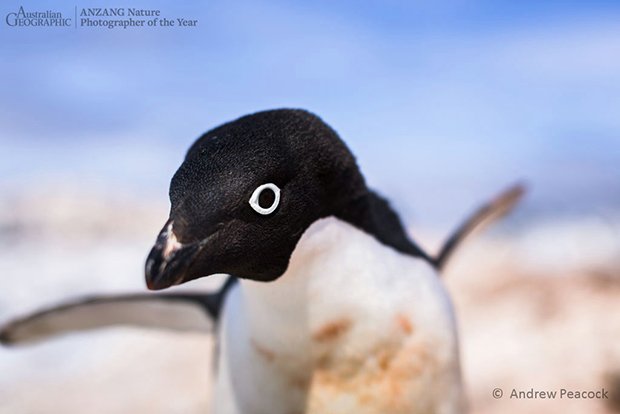
CATEGORY: WILDERNESS LANDSCAPES (winner)
Reflection of fire
Vincent Antony, Victoria
The calm before the storm: with a fire in the national park creeping along, the wind would come up and then die down, leaving only minutes to capture the glassy surface and reflections.
Lake Eildon National Park, Victoria
Sony Alfa 700, 80–200mm lens at 160mm, 1/45, f10, ISO 500, tripod and remote switch.

PORTFOLIO PRIZE (2/6)
Synchronicity
Using an unprotected digital SLR while paddling in frigid waters is a challenge; I was pleased to capture this image of gentoo penguins (Pygoscelis papua) after many attempts.

WILDERNESS LANDSCAPES (runner-up)
Marovo Lagoon, Solomon Islands
Stuart Chape, Samoa
One of the world’s largest coral reef lagoons, the Marovo Lagoon is located in Western Province, Solomon Islands. Although parts of the lagoon are showing the signs of human impact, it’s still characterised by rich marine and terrestrial biodiversity, including spectacular coral reefs.
Western Province, Solomon Islands
Mamiya 645, 21mm lens, 1/125, f8, ISO 100, polariser, handheld.

CATEGORY: OUR IMPACT (winner)
Shipwreck, Solomon Islands
Stuart Chape, Samoa
The Pacific Ocean and islands are under severe threat from marine and land pollution. Uncontrolled dumping of waste contaminates near-shore waters and land areas of many Pacific islands, compromising ecosystem health and the welfare of people. This image epitomises the scale of degradation that is occurring.
Guadalcanal, Solomon Islands
Sony A99, 24mm lens, 1/60, f11, ISO 100, UV filter, handheld.

UNDERWATER SUBJECT (runner-up)
Whip goby
Shannon Conway, Western Australia
While diving in the notoriously stiff currents off Tala Island in Komodo National Park, I discovered this extraordinarily large whip coral (Cirripathes sp.) occupied by a small goby (Bryaninops sp.). I used the coral for negative space and a wide aperture for macro to create ‘bokeh’, or aesthetic blur.
Tala Island, Komodo National Park, Indonesia
Nikon D300, Nikon AF-S 105mm f/2.8 VR lens, 1/250, f13, ISO 200, twin INON 220 strobes.

CATEGORY: BOTANICAL SUBJECT (winner)
Fungi in mist
Raoul Slater, Queensland
Every morning for a fortnight, a cluster of fungi would burst from a pile of wood chips, but then shrivel and disappear a few hours after sunrise. I would lie in the mulch and focus my macro lens through the mushrooms, looking for the effects of atmosphere in the misty light.
Noosa Botanic Gardens, Sunshine Coast, Queensland
Canon EOS 5D MkII, 100mm f/2.8 macro lens, 1/200, f5.6, 400 ISO, handheld.

CATEGORY: ANIMAL BEHAVIOUR (winner)
King penguins
Peter Lambert, Western Australia
On a typical grey and overcast day on South Georgia, I was photographing countless king penguins (Aptenodytes patagonicus) when a small herd of introduced reindeer (Rangifer tarandus) ran through the huddle. This is probably an outdated photograph now because many of the reindeer have since been culled.
St. Andrews Bay, South Georgia
Nikon D3, Nikon 70–200mm f/2.8 lens at 200mm, 1/400, f5.6, ISO 200, handheld.

CATEGORY: JUNIOR (winner)
Frog patterns
Oliver Sekulic, 16, New South Wales
The intricate patterns and colours covering its skin and eyes make this Peron’s tree frog (Litoria peronii) an irresistible photo subject and easily distinguishable from other tree frogs. It’s not too shy, either – it jumped onto my camera lens soon after I took this photo!
South coast, New South Wales
Sony Nex-5, 18–55mm lens at 55mm, 1/200, f8, ISO 1600, UV(c) filter, handheld.
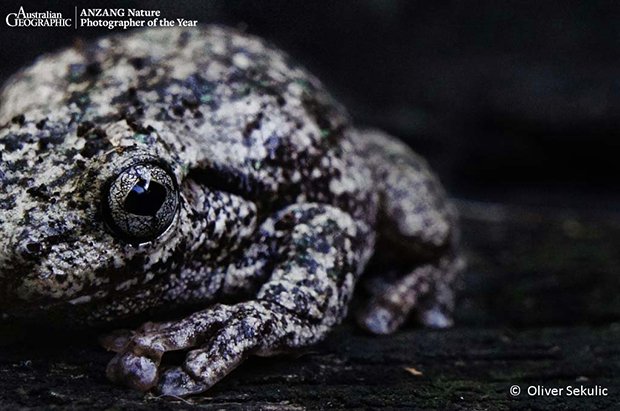
ANIMAL PORTRAIT (finalist)
Moving home
Trevor Penfold, Raglan, New Zealand
At night, strawberry hermit crabs (Coenobita perlatus) scurry across the white beaches of Lady Elliot Island. They are terrestrial hermit crabs and this one had a particularly large shell. It was heading for the ocean as it needed to refresh its supply of water.
Lady Elliot Island, Great Barrier Reef
Canon EOS 1D MkIII, Canon EF 180mm f/3.5L USM macro lens, 1/200, f8, ISO 100, Canon Speedlite 580EX, handheld.

ANIMAL PORTRAIT (finalist)
Green Tree Python
Stephen Zozaya, Queensland
Cape York Peninsula harbours several species found nowhere else in Australia, but which are widespread in New Guinea. Green tree pythons (Morelia viridis) are one example; they are only known in the Iron and McIlwraith ranges.
Iron Range, Cape York Peninsula, Queensland
Canon EOS 7D, Canon EF-S 14–22mm f/3.4–4.5 lens, 1/200, f20, ISO 100, Canon 430EX II Speedlite fired remotely, handheld.

ANIMAL BEHAVIOUR (finalist)
This way
Ray Alley, New South Wales
This pod of bottlenose dolphins (Tursiops truncatus) was cruising along and having a great time as they headed north along Bennetts Beach, a little to the north of Port Stephens.
Port Stephens, New South Wales
Nikon D3S, Nikon 70–200mm f/2.8 IF ED VR2 lens, 1/250, f8, ISO 320, handheld (image taken from a Robinson R44 helicopter).

BOTANICAL SUBJECT (finalist)
Gums during drought
Raoul Ribot, Victoria
After years of drought, a eucalyptus forest on the riverbank of the Murrumbidgee River is left dry and dusty in 2009.
Murrumbidgee River, New South Wales
Sony HDR-SR12, f/4.9–58.8mm lens, 1/60, f4, handheld.

BLACK AND WHITE (finalist)
Regenerating
Peter Hill, New South Wales
This section of forest in Barrington Tops National Park was logged and suffered from a fire several years ago, but is now well the way to recovery and regeneration. The afternoon sun caught the tops of the trees and the new foliage perfectly.
Stewarts Brook State Forest, Barrington Tops National Park precinct, New South Wales
Canon EOS 10D, Canon EF 24–70mm f/2.8L lens at 24mm, 1/180, f8, ISO 100, handheld (to shoot infrared, a B+W IR filter was inserted within the camera body, replacing the original hot mirror filter).
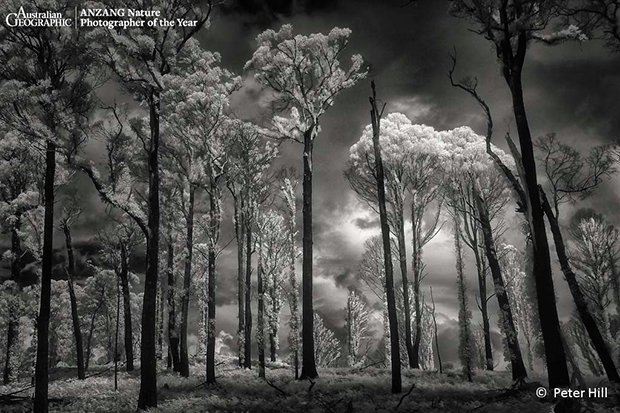
WILDERNESS LANDSCAPES (finalist)
Silcrete Island
Peter Elfes, New South Wales
Australia’s largest lake retained water for a record-breaking four years, which encouraged algae, bacteria and single-cell life forms (known as archaebacteria) to form. These microorganisms are considered the oldest life forms on Earth. The colour of the water comes from pigments within the cell that produce carotenoids, possibly to protect the cell from ultraviolet light that would otherwise destroy it.
Kati Thanda–Lake Eyre National Park, South Australia
Canon EOS 5D MkII, 24–70mm at 50mm f/2.8 lens, 1/500, f7.1, ISO 320.

JUNIOR (finalist)
Spikes at every corner!
Maud Graillot-Denaix, 15, France
During a holiday in Australia we hoped to see numbats (Myrmecobius fasciatus) and we spent hours looking for them unsuccessfully. At noon, while my brothers and I were not concentrating as hard as we were in the morning, I found four sleeping echidnas (Echidna hystrix). We spent the whole afternoon watching their behaviour.
Narrogin, Western Australia
Canon EOS 40D, 300mm lens, 1/200, f4, ISO 500, tripod.

THREATENED SPECIES (finalist)
Bounce Back
Mark Woods, South Australia
Operation bounce back helped this population of yellow-footed rock wallabies (Petrogale xanthopus) recover in the Flinders Ranges. It was a pleasure to spend a couple of hours observing them in their natural habitat.
Brachina Gorge, Flinders Ranges, South Australia
Sony DSLR-A300, Sigma APO 150–500mm f/5–6.3 DG OS HSM lens at 230mm, 1/125, f5.6, ISO 400, handheld.
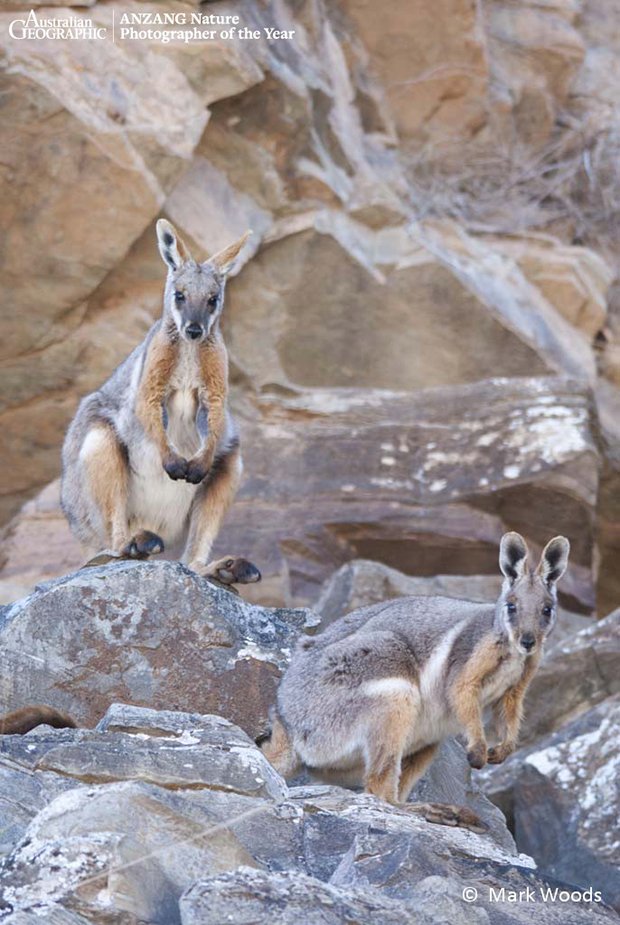
OUR IMPACT (finalist)
Harvesting groundwater
Liz Rogers, Victoria
Preserved in the cold, fresh water, an old harvester has been sitting on the bottom of this sinkhole for decades – a symbol of the ‘out of sight, out of mind’ mentality. Greater demand, drought and dropping water levels have increased our awareness of the importance of groundwater as a resource requiring protection.
One tree sinkhole, Mt Gambier region, South Australia
Canon EOS 5D MkII, Canon 14mm f/2.8L II USM lens, 1/125, f7.1, ISO 400, Aquatica underwater housing with 8″ dome port, 2 x INON Z240 MkIV underwater strobes, 1 x INON Z240 MkIV underwater strobe held by model, off-camera strobes triggered using a Triggerfish light sensor; handheld.

INTERPRETIVE (finalist)
Frozen visage
Kah Kit Yoong, Victoria
Inside an ice cave at Fox Glacier, I lay on my belly photographing the pool of water and the icy textures reflected in it. When I tilted my head, I realised the potential for an abstract image with strong anthropomorphic qualities. All I had to do was rotate the image 90°.
Fox Glacier, New Zealand
Canon EOS 5D MkII, Canon 16–35mm f/2.8L lens at 29mm, 1/160, f9, ISO 200, handheld.

BOTANICAL SUBJECT (finalist)
Bee visiting
Jennie Stock, Western Australia
I noticed bees were visiting the huge mottlecah (Eucalyptus macrocarpa) flowers, so I composed the shot and waited patiently for the perfect moment when one hovered in just the right place. It is interesting that these small bees can pollinate such a large flower.
Dryandra woodland, Western Australia
Nikon D3000, Sigma 150–500mm f/5–6.3 DG OS HSM lens at 350mm, 1/320, f11, ISO 400, tripod

UNDERWATER SUBJECT (finalist)
Cuttlefish mating
Ignacio Palacios, New South Wales
While diving off Lady Elliot Island I photographed these cuttlefish mating. There was a big group of them but this couple was not shy. Cuttlefish are marine animals of the order Sepiida and, despite their name, are not fish but molluscs. They have the remarkable ability to rapidly alter their skin colour at will, which allows them to communicate with other cuttlefish and camouflage themselves.
Lady Elliot Island, Great Barrier Reef
Canon G10, 28mm lens, 1/250, f2.8, ISO 80, underwater flash.

WILDERNESS LANDSCAPES (finalist)
Hamersley Gorge waterfall
Ignacio Palacios, New South Wales
Hamersley is quite different from the other gorges in Karijini National Park. It takes hours to get there by car, but its dramatic colours, unique textures and rock formations make it well worth the effort. There is a beautiful little waterfall to complete the brilliant scenery.
Karijini National Park, Western Australia
Pentax 645D, Pentax SMC DA 645 25mm f/4 AL (IF) SDM AW lens, 2 seconds, f11, ISO 100, tripod.

THREATENED SPECIES (finalist)
A giant appetite
George Madani, New South Wales
The giant barred frog (Mixophyes iterates), silent sentinel of the creek’s bank, is motionless as it waits. Oblivious to the danger, a young rat scuttles among the leaf litter before it’s trapped by the most unlikely of hunters.
Bulahdelah, New South Wales
Panasonic DMC-FT3, 5mm lens at 29mm, 1/60, f3.3, ISO 100, auto flash.

OUR IMPACT (finalist)
The vanishing billabong
Gary Steer, New South Wales
Climate change and record hot and dry periods are impacting on the land and water availability. Although billabongs provide a temporary water supply for animals after flooding, it’s not long before soakage and evaporation occurs. Pastoralists must then resort to pumping water from bores into troughs. Converging livestock and native animals also inflict heavy grazing pressure on the surrounding vegetation.
Near to the Diamantina River, Queensland.
Canon EOS 5D MkII, Canon EF 70-200mm f/4L IS USM lens at 70mm, 1/320, f11, ISO 100, aerial, handheld.

JUNIOR (finalist)
Australian trolls
Brieuc Graillot-Denaix, 17, France
During a family holiday we visited The Pinnacles, spectacular geological formations. Beforehand I had some pictures in mind – I wanted to photograph them at night, framed against a starry sky. When we arrived the sky was cloudy, so I took advantage of a slow shutter speed to capture the movement of the clouds and I placed a spotlight on the rocks.
Cervantes, Western Australia
Canon EOS 1D MkIV, 17–40mm at 17mm, 30 seconds, f4, 1600 ISO, tripod, torchlights.

INTERPRETIVE (finalist)
Sea Egg no. 7
William Goodwin, Birmingham, Alabama, USA
The planet’s oceans are the womb of all life on Earth. This premise underlies my Ocean Ova series of images, of which this is the seventh. I manipulated the original image of a Tube Anemone (Cerianthus sp.) shot at night in an attempt to embody this premise.
Lembeh Strait, North Sulawesi, Indonesia
Sony Nex-5N, 18–55mm lens at 26mm, 1/60, f4, ISO 1000, handheld (image made at night with lighting from 2 x UK Aqualite Video).

UNDERWATER SUBJECT (finalist)
BamBam
Vanessa Mignon, New South Wales
This curious and playful humpback calf (Megaptera novaeangliae) chased us around for a while and we nicknamed it ‘BamBam’. This shot is special to me because of the memory, but also because I feel it captures their graceful and dynamic beauty.
Ha’apai, Kingdom of Tonga
Canon EOS 5D MkII, Canon 16–35mm f/2.8L lens, 1/200, f6.3, ISO 320, Subal underwater housing.
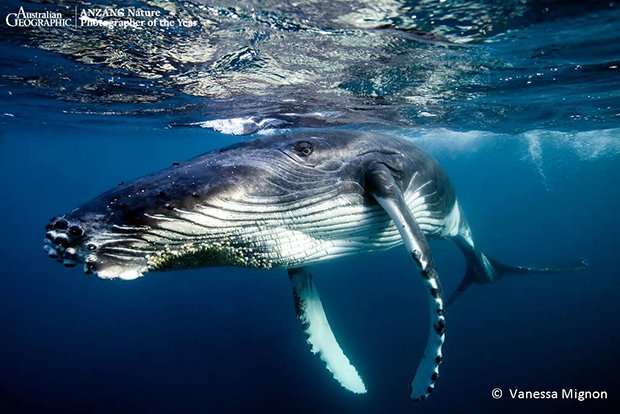
BLACK AND WHITE (finalist)
Bull kelp
Graham Morgan, New South Wales
Glistening bull kelp (Durvillaea potatorum) sculpted by the ocean surges into an infinite array of patterns.
Enderby Island, Auckland Islands, New Zealand
Canon EOS 1Dx, Canon 70–300mm lens at 300mm, 1/2000, f5.6, ISO 800, handheld.

ANIMAL BEHAVIOUR (finalist)
Giant flax weevil
Thomas Burns, Cambridge, New Zealand
The jagged edge of flax, where giant flax weevils (Anagotus fairburni) have been feeding, shines brightly in torchlight. After searching several bushes, I found weevils feeding on the flax leaves, but the pose of this individual caught my attention.
Maud Island, Marlborough Sounds, New Zealand
Canon 7D, Canon 100mm f/2.8L IS USM macro lens, 1/200, f11, ISO 400, 2 x Canon 430EX II flashes, handheld.

CATEGORY: BLACK AND WHITE (winner)
Osprey’s early morning catch
John Van-Den-Broeke, New South Wales
Some days I spend 3-4 hours paddling and drifting in my canoe, looking for photo subjects. This method is great because it does not disturb wildlife and you can immerse yourself in nature. This osprey (Pandion cristatus) caught a fish and flew directly at me. It was a great moment.
Cudgen Creek, Kingscliff, New South Wales
Canon EOS 1D MkIV, Canon EF 70-200mm f/2.8 IS lens + 1.4 x at 280mm, 1/1600, f8, ISO 2000, handheld.


